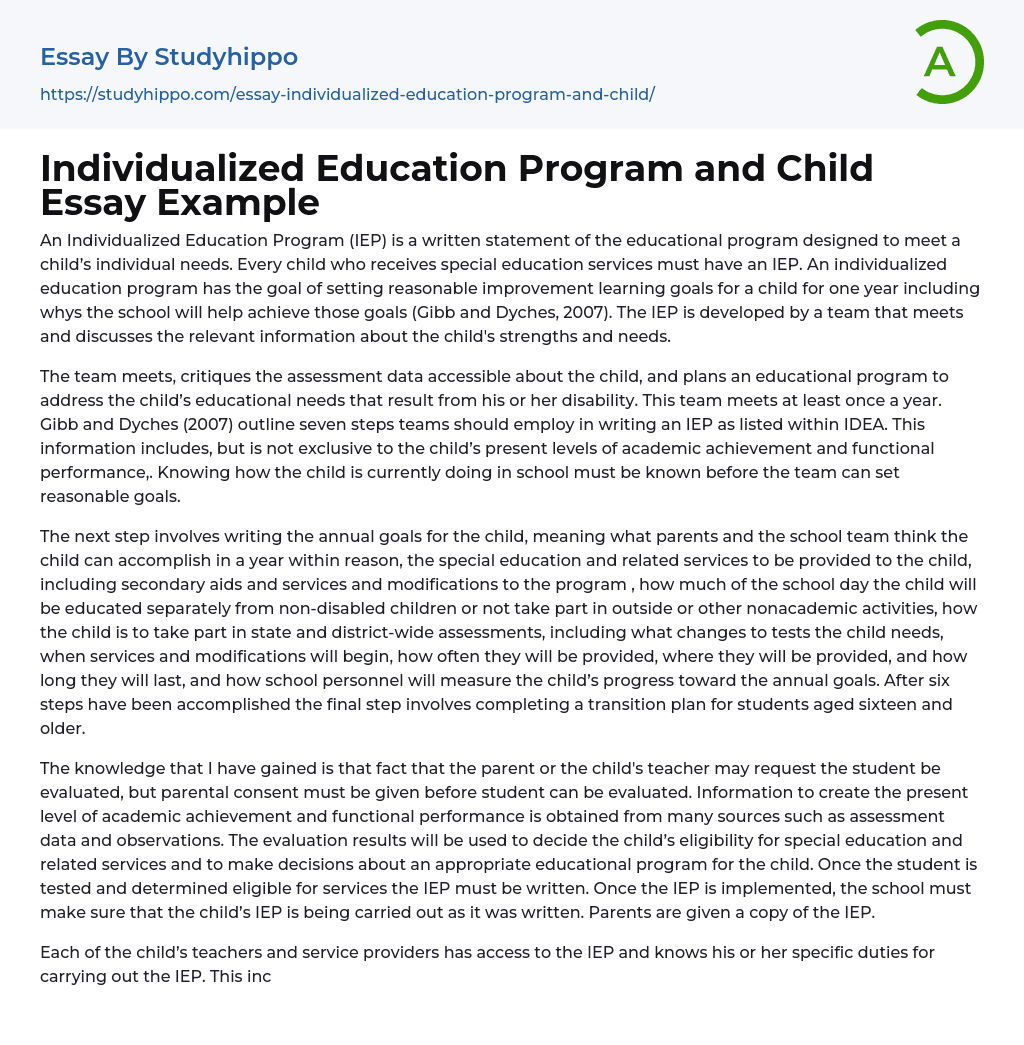An IEP, also known as an Individualized Education Program, is a written statement that tailors the educational program to address the unique requirements of a child. It is compulsory for all children who receive special education services to possess an IEP. The primary objective of this program is to establish achievable learning goals for a child in one year and outline the school's assistance in attaining those objectives (Gibb and Dyches, 2007). Crafting an IEP entails a team meeting where pertinent information regarding the child's strengths and needs is discussed.
The team gathers and analyzes assessment data to develop an educational program that targets the child's disability-related educational needs. This team meets once a year, and according to Gibb and Dyches (2007), there are seven steps that teams must follow when creating an Individualized Education Program (IEP) as specif
...ied in IDEA. This information covers different aspects like the child's current academic achievement and functional performance. It is essential to comprehend the child's school progress before setting attainable goals.
The following paragraph is a unified andversion of the text, while preserving the and their contents:
The next step in the process entails developing the annual goals for the child, which reflect the attainable objectives determined by parents and the school team within a year. These goals should consider the provision of special education, related services, secondary aids and modifications to accommodate the child's needs, as well as the extent to which the child will be educated separately from non-disabled peers or participate in nonacademic activities. Additionally, it includes determining the child's involvement in state and district-wide assessments, specifying any necessary modifications to
tests. The plan should also address the commencement, frequency, location, and duration of services and modifications, and how school personnel will assess and document the child's progress towards achieving the annual goals. Finally, for students aged sixteen and older, it is essential to complete a transition plan as the last step in this process.
Both the parent and the child's teacher can request an evaluation for the student, but parental consent is required. Various sources, including assessment data and observations, are used to gather information and create a report on the student's current academic achievement and functional performance. The evaluation results are then used to determine eligibility for special education and related services, as well as make decisions regarding an appropriate educational program. Once the student has been tested and found eligible for services, an Individualized Education Program (IEP) must be written. It is crucial for the school to ensure that the child's IEP is followed precisely as it was written. Parents will receive a copy of this IEP.
The child's teachers and service providers have access to the child's Individualized Education Program (IEP) and are aware of their specific responsibilities. They must provide the accommodations, modifications, and support outlined in the IEP. The child's progress towards their annual goals is regularly assessed and communicated to the parents. The parents are informed about whether the progress is sufficient for the child to meet their goals by year-end. The IEP team reviews the child's IEP annually or more frequently if requested by either the parents or school. Additionally, a reevaluation must be conducted for the child every three years.
- Interpretation essays
- Plagiarism essays
- Analogy essays
- Learning English essays
- Adolescence essays
- Childhood essays
- Growth Mindset essays
- Individual essays
- Infant essays
- Is Google Making Us Stupid essays
- Coaching essays
- Critical Thinking essays
- homework essays
- Learning essays
- Library essays
- Listening essays
- Literacy essays
- Mentor essays
- Physical Education essays
- Project essays
- Reading essays
- Research essays
- Sex Education essays
- Social Studies essays
- Standardized Testing essays
- Study Plan essays
- Teaching essays




